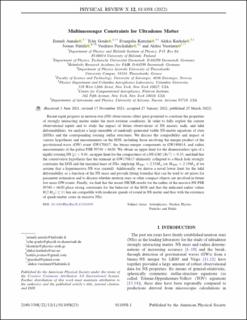| dc.contributor.author | Annala, Eemeli | |
| dc.contributor.author | Gorda, Tyler | |
| dc.contributor.author | Katerini, Evangelia | |
| dc.contributor.author | Kurkela, Eero Aleksi | |
| dc.contributor.author | Nättilä, Joonas | |
| dc.contributor.author | Paschalidis, Vasileios | |
| dc.contributor.author | Vuorinen, Aleksi | |
| dc.date.accessioned | 2023-01-19T08:49:00Z | |
| dc.date.available | 2023-01-19T08:49:00Z | |
| dc.date.created | 2022-04-24T15:57:19Z | |
| dc.date.issued | 2022 | |
| dc.identifier.citation | Annala, E., Gorda, T., Katerini, E., Kurkela, A., Nättilä, J., Paschalidis, V., & Vuorinen, A. (2022). Multimessenger Constraints for Ultradense Matter. Physical Review X, 12(1), 011058. | en_US |
| dc.identifier.issn | 2160-3308 | |
| dc.identifier.uri | https://hdl.handle.net/11250/3044476 | |
| dc.description.abstract | Recent rapid progress in neutron-star (NS) observations offers great potential to constrain the properties of strongly interacting matter under the most extreme conditions. In order to fully exploit the current observational inputs and to study the impact of future observations of NS masses, radii, and tidal deformabilities, we analyze a large ensemble of randomly generated viable NS-matter equations of state (EOSs) and the corresponding rotating stellar structures. We discuss the compatibility and impact of various hypotheses and measurements on the EOS, including those involving the merger product of the gravitational-wave (GW) event GW170817, the binary-merger components in GW190814, and radius measurements of the pulsar PSR J0740+6620. We obtain an upper limit for the dimensionless spin of a rigidly rotating NS |χ|<0.81, an upper limit for the compactness of a NS GM/(Rc2)<0.33, and find that the conservative hypothesis that the remnant in GW170817 ultimately collapsed to a black hole strongly constrains the EOS and the maximal mass of NSs, implying MTOV<2.53M⊙ (or MTOV<2.19M⊙ if we assume that a hypermassive NS was created). Additionally, we derive a novel lower limit for the tidal deformability as a function of the NS mass and provide fitting formulas that can be used to set priors for parameter estimation and to discern whether neutron stars or other compact objects are involved in future low-mass GW events. Finally, we find that the recent NICER results for the radius of the massive NS PSR J0740+6620 place strong constraints for the behavior of the EOS and that the indicated radius values R(2 M⊙)≳11 km are compatible with moderate speeds of sound in NS matter and thus with the existence of quark-matter cores in massive NSs | en_US |
| dc.language.iso | eng | en_US |
| dc.publisher | American Physical Society | en_US |
| dc.rights | Navngivelse 4.0 Internasjonal | * |
| dc.rights.uri | http://creativecommons.org/licenses/by/4.0/deed.no | * |
| dc.title | Multimessenger Constraints for Ultradense Matter | en_US |
| dc.title.alternative | Multimessenger Constraints for Ultradense Matter | en_US |
| dc.type | Peer reviewed | en_US |
| dc.type | Journal article | en_US |
| dc.description.version | publishedVersion | en_US |
| dc.rights.holder | The author | en_US |
| dc.subject.nsi | VDP::Matematikk og Naturvitenskap: 400 | en_US |
| dc.source.volume | 12 | en_US |
| dc.source.journal | Physical Review X | en_US |
| dc.source.issue | 1 | en_US |
| dc.identifier.doi | 10.1103/PhysRevX.12.011058 | |
| dc.identifier.cristin | 2018707 | |
| cristin.ispublished | true | |
| cristin.fulltext | original | |
| cristin.qualitycode | 2 | |

